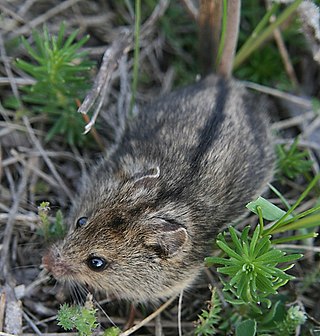
Dipodoidea is a superfamily of rodents, also known as dipodoids, found across the Northern Hemisphere. This superfamily includes over 50 species among the 16 genera in 3 families. They include the jerboas, jumping mice, and birch mice. Different species are found in grassland, deserts, and forests. They are all capable of saltation, a feature that is most highly evolved in the desert-dwelling jerboas.

Birch mice are small jumping rodents that resemble mice with long, tufted tails and very long hind legs, allowing for remarkable leaps. They are the only extant members of the family Sminthidae. They are native to Eurasian forests and steppes. All variants possess a long tail of 65 to 110 mm of length and weigh about 6 to 14 g. Head and body length of 50 to 90 mm and hind foot length of 14 to 18 mm. The animal's skin color is light brown or dark-brown to brownish yellow on the upper side and paler on the underside, but generally brownish. Birch mice have a vast geographic distribution in that they inhabit a wide variety of habitats, from semiarid areas to subalpine meadows. Although they have a diverse region of areas, their molecular and anatomical markers have claimed that Birch mice originated from Central Asia.Birch mice have a systematic of the genus of Sicista, they look at the male reproductive organs and cytogenic data.

The northern birch mouse is a small rodent about 5 to 8 cm long, weighing 5 to 13 g. It lives in northern Europe and Asia in forest and marsh zones.
The Armenian birch mouse is a species of rodent in the family Sminthidae.
The Caucasian birch mouse is a species of rodent in the family Sminthidae, that is endemic to Russia. Reports that it occurs in Turkey probably refer to Armenian birch mouse, from which it can only be reliably distinguished on the basis of karyotype. The Caucasian birch mouse inhabits the Western Montane Caucasus area, land situated between the Black sea and the Caspian sea.
The Kazbeg birch mouse is a species of rodent in the family Sminthidae. It is found in Georgia and Russia and has a natural habitat of temperate forests.
The Kluchor birch mouse is a species of rodent in the family Sminthidae. It is endemic to Russia. Its natural habitat is temperate forests.
The Altai birch mouse is a species of rodent in the family Sminthidae. It is native to Russia and Kazakhstan. A baby Altai birch mouse is called a 'pinkie, kitten or pup'. The females are called 'doe' and males 'buck'. A Altai birch mouse group is called a 'nest, colony, harvest, horde or mischief'.
The gray birch mouse is a species of rodent in the family Sminthidae. It is endemic to Kazakhstan, but possibly ranges into China. Its natural habitat is temperate forests.
The Severtzov's birch mouse, or dark birch mouse is a species of rodent in the family Sminthidae. It is endemic to East-European steppes.
Strand's birch mouse is a species of rodent in the family Sminthidae. It is endemic to Russia.
The Tien Shan birch mouse is a species of rodent in the family Sminthidae. It is found in China, Kazakhstan and Kyrgyzstan.
Sicista concolor, the Chinese birch mouse, is a species of rodent in the family Sminthidae. It is native to China, India and Pakistan.

Sminthidae is a family of mouse-like jumping rodents. They are represented by only one extant genus, Sicista, represented by 19 species found throughout most of Eurasia, from central Europe east to Siberia, and south to southern China. However, they were much more diverse and had a much wider range in prehistoric times, having multiple genera and being found not only in Eurasia but also throughout North America, where they existed up to the early Pleistocene. They have a well-attested fossil record which dates as far back as the early Oligocene.

The Hungarian birch mouse is a species of birch mouse in the family Sminthidae. It was once found throughout Central Europe and Romania, but is now only known from two isolated populations in Hungary and Transylvania in Romania, each of which belong to their own subspecies.
Nordmann's birch mouse is a species of birch mouse in the family Sminthidae. It is named after Finnish biologist Alexander von Nordmann. It is native to eastern and southeastern Europe.





